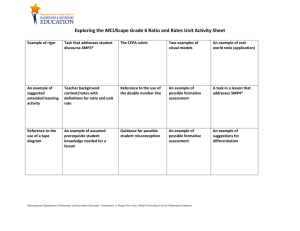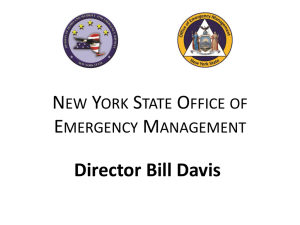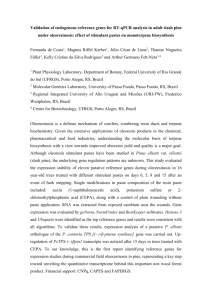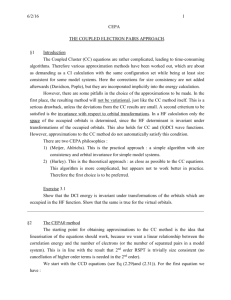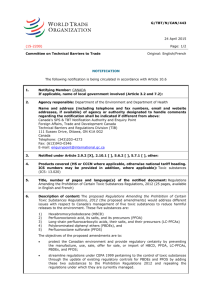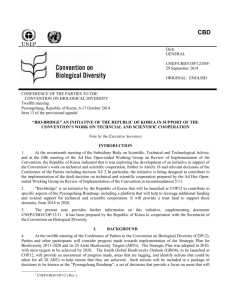Executive Summary - Convention on Biological Diversity
advertisement
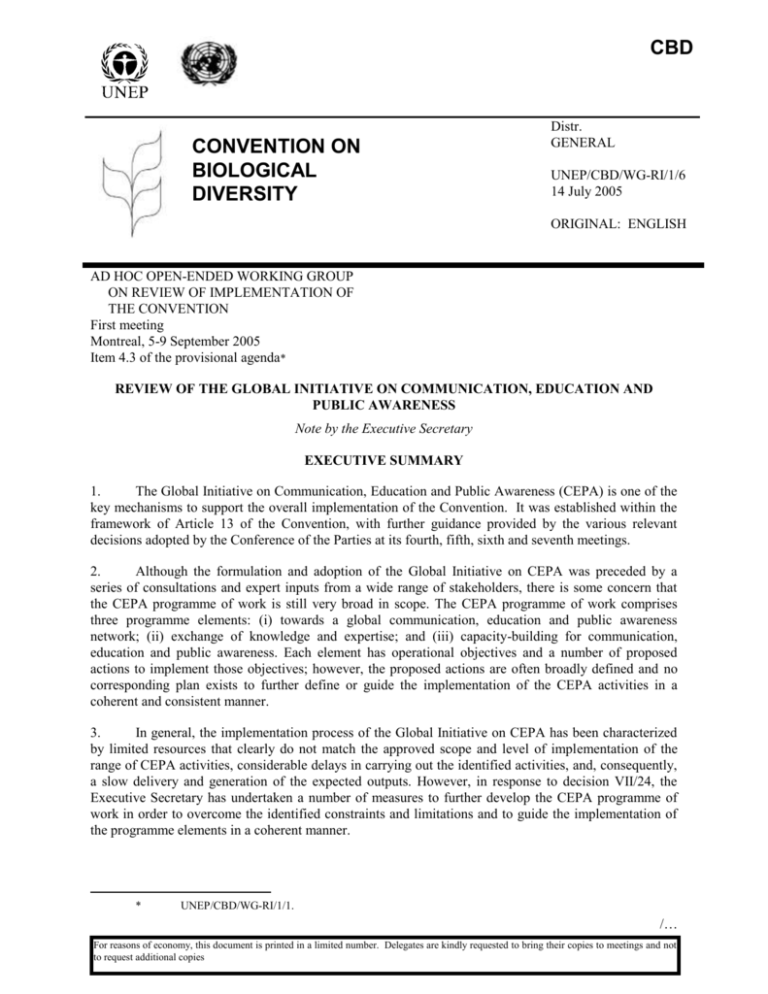
CBD CONVENTION ON BIOLOGICAL DIVERSITY Distr. GENERAL UNEP/CBD/WG-RI/1/6 14 July 2005 ORIGINAL: ENGLISH AD HOC OPEN-ENDED WORKING GROUP ON REVIEW OF IMPLEMENTATION OF THE CONVENTION First meeting Montreal, 5-9 September 2005 Item 4.3 of the provisional agenda* REVIEW OF THE GLOBAL INITIATIVE ON COMMUNICATION, EDUCATION AND PUBLIC AWARENESS Note by the Executive Secretary EXECUTIVE SUMMARY 1. The Global Initiative on Communication, Education and Public Awareness (CEPA) is one of the key mechanisms to support the overall implementation of the Convention. It was established within the framework of Article 13 of the Convention, with further guidance provided by the various relevant decisions adopted by the Conference of the Parties at its fourth, fifth, sixth and seventh meetings. 2. Although the formulation and adoption of the Global Initiative on CEPA was preceded by a series of consultations and expert inputs from a wide range of stakeholders, there is some concern that the CEPA programme of work is still very broad in scope. The CEPA programme of work comprises three programme elements: (i) towards a global communication, education and public awareness network; (ii) exchange of knowledge and expertise; and (iii) capacity-building for communication, education and public awareness. Each element has operational objectives and a number of proposed actions to implement those objectives; however, the proposed actions are often broadly defined and no corresponding plan exists to further define or guide the implementation of the CEPA activities in a coherent and consistent manner. 3. In general, the implementation process of the Global Initiative on CEPA has been characterized by limited resources that clearly do not match the approved scope and level of implementation of the range of CEPA activities, considerable delays in carrying out the identified activities, and, consequently, a slow delivery and generation of the expected outputs. However, in response to decision VII/24, the Executive Secretary has undertaken a number of measures to further develop the CEPA programme of work in order to overcome the identified constraints and limitations and to guide the implementation of the programme elements in a coherent manner. * UNEP/CBD/WG-RI/1/1. /… For reasons of economy, this document is printed in a limited number. Delegates are kindly requested to bring their copies to meetings and not to request additional copies UNEP/CBD/WG-RI/1/6 Page 2 4. The present note has been prepared by the Executive Secretary to assist the Ad Hoc Open-ended Working Group on Review of Implementation of the Convention to review the status of implementation of the Global Initiative on CEPA, to consider a set of suggested recommendations to strengthen the CEPA initiative and to enhance CEPA’s contribution to the overall implementation of the Convention and the Strategic Plan. SUGGESTED RECOMMENDATIONS The Working Group on the Review of Implementation of the Convention may wish to: 1. Take note of the draft list of priority activities for the CEPA initiative and the draft plan for their implementation prepared by the Executive Secretary (UNEP/CBD/WG-RI/1/INF/10). 2. Request the Executive Secretary, in consultation with the CEPA Informal Advisory Committee, to finalize the list of priority activities for the CEPA initiative and the plan for their implementation, taking into account the views expressed by Parties, other Governments and organizations at the Working Group on Review of Implementation, including the need for the plan of implementation to address: (a) Intended audiences, including key stakeholders and the general public; (b) Key messages to communicate to target audiences (i) biodiversity as a concept and (ii) the role and work of the Convention, including messages that link biodiversity to the broader issue of sustainable development; (c) activities; The institutional framework, means and resources for the implementation of identified (d) The distinction between activities at the national and global level and distribution of tasks among Parties, the Secretariat and partners; (e) The development and maintenance of partnerships and networks to facilitate implementation of activities through knowledge sharing, harmonization of activities and capacity-building; (f) (g) outputs; A modular approach for implementation of identified activities; The setting of realistic milestones and deadlines tied to the generation of relevant (h) Outputs that meet the requirements of the different categories of users/audiences; (i) The intended use and impacts of the outputs; (j) Mechanisms for monitoring and assessment of the activities and their results; (k) A comprehensive analysis of the funding needs for implementation of the plan. 3. Recommend that the Conference of the Parties at its eighth meeting: (a) Note with appreciation the review and further development of the CEPA programme of work prepared by the Executive Secretary with the support of the CEPA Informal Advisory Committee convened in response to decision VII/24 and, in particular, their efforts to identify a list of priority /… UNEP/CBD/WG-RI/1/6 Page 3 activities in the CEPA programme of work to serve as the focus for the implementation of the initiative, as well as a plan for the implementation of the identified activities, (b) Welcome the list of priority activities for the CEPA initiative comprising the CEPA dimensions of the ongoing programmes of work of the Convention in the thematic areas and cross-cutting issues, including the CEPA programme of work in the annex to decision VI/19, and the plan for the implementation of the identified priority activities; 1/ (c) Invite Parties and the Global Environmental Facility to contribute and make available the necessary financial resources to implement the identified CEPA priority activities; and (d) Invite Parties, international organizations and other partners to fully participate in, and contribute to, the implementation of the identified CEPA priority activities. 1/ The list of priority activities and draft action plan for their implementation is being prepared in consultation with the CEPA Informal Advisory Committee and will be available in late September 2005. /… UNEP/CBD/WG-RI/1/6 Page 4 I. INTRODUCTION 1. The present note has been prepared by the Executive Secretary to assist the Ad-Hoc Open-ended Working Group on Review of Implementation of the Convention to review the status of implementation of the Global Initiative on Communication, Education and Public Awareness (CEPA) as part of the overall process of reviewing the impacts and effectiveness of existing processes under the Convention, and to consider ways and means of identifying and overcoming obstacles to the effective implementation of the Convention. 2. Section II of the present note provides an overview of the mandate for, and evolution of, the CEPA initiative, while section III examines the status of its implementation. Section IV analyses the lessons learned with a focus on the overall implementation process. Section V proposes a number of possible options to strengthen the CEPA initiative for the consideration of the Ad Hoc Open-ended Working Group on Review of Implementation of the Convention. II. OVERVIEW OF THE CEPA INITIATIVE AND REVIEW OF ITS IMPLEMENTATION: BACKGROUND AND EVOLUTION 3. Article 13 of the Convention on Biological Diversity establishes the overall mandate for public education and awareness activities. 4. In adopting decision IV/10, the Conference of the Parties, at its fourth meeting, provided guidance on education and public awareness within the Convention process and urged Parties to place special emphasis on the requirements of Article 13 of the Convention in the development of their national strategies and action plans. The Conference of the Parties called on Parties to: promote education on biological diversity through relevant institutions, including non-governmental organizations; allocate appropriate resources for the strategic use of education and communication instruments; integrate biodiversity concerns into education strategies; and support initiatives by major groups that foster stakeholder participation in biodiversity conservation and sustainable use and that integrate biodiversity conservation matters into their practices and educational programmes. The Conference of the Parties also invited the United Nations Educational, Scientific and Cultural Organization (UNESCO) to consider launching a global initiative on biological diversity education, training and public awareness and requested the Executive Secretary to explore the feasibility of such an initiative and to report to the fifth meeting of the Conference of the Parties. 5. On the basis of consultations between the Secretariat and UNESCO, and with the involvement of other relevant international organizations and partners, a proposal for a Global Initiative on biological diversity education, training and public awareness was developed for consideration by the Conference of the Parties, which, at its fifth meeting, gave further direction to the development of biodiversity education and public awareness in decision V/17. In that decision, the Conference of the Parties requested the Executive Secretary, in cooperation with UNESCO, to convene a consultative working group of experts, including representatives of Parties and other relevant bodies, to further advance and, in particular, to identify priority activities for, the proposed global initiative on biological diversity education and public awareness. 6. A Consultative Working Group of Experts on Biological Diversity Education and Public Awareness comprising representatives of UNESCO, UNEP, World Bank, UNITAR, IUCN and WWF as well as some Parties and other relevant bodies met three times prior to the sixth meeting of the Conference of the Parties: in Paris, 11-13 July 2000; in Bergen, Norway, 16-17 November 2000; and in Bilbao, Spain, 5-7 November 2001. The group identified priority activities for the proposed global initiative, taking into account priorities identified in the Strategic Plan of the Convention and in the approved programmes of work, and formulated a draft programme of work for consideration at the sixth meeting of the Conference of the Parties. /… UNEP/CBD/WG-RI/1/6 Page 5 7. At its sixth meeting and recalling the provisions of Article 13, the Conference of the Parties adopted the Global Initiative on Communication, Education and Public Awareness (CEPA) and the related programme of work (decision VI/19). The programme of work comprises three programme elements (towards a global communication, education and public awareness network; exchange of knowledge and expertise; and capacity-building for communication, education and public awareness), each with operational objectives and proposed actions to guide implementation by key partners. The three elements represent two strategic priorities: (i) institutional arrangements; and (ii) programmatic priority areas in the Global Initiative. By decision VI/19, the Conference of the Parties also requested the Executive Secretary to consult with UNESCO, UNEP, IUCN and the Consultative Working Group of Experts established by decision V/17, as well as any relevant institutions, to, among other things, monitor and evaluate the implementation of the Global Initiative on CEPA, specifically the start-up phase of the programme of work. 8. Goal 4 of the Strategic Plan of the Convention, adopted at the same meeting (There is better understanding of the importance of biodiversity and of the Convention, and this has led to broader engagement across society in implementation), provides the umbrella framework within which further development and implementation of biodiversity communication, education and public awareness initiatives could be carried out under the Convention. 9. In response to decision VI/19, the Consultative Working Group of Experts on CEPA met in Paris, from 27 to 29 October 2003 to propose concrete modalities for the future development of programme activities. The outcomes and recommendations of the meeting included a draft matrix summarizing suggestions and proposals to enhance the implementation of the Global Initiative on CEPA, including, inter alia, key elements required to develop a strategy to guide the implementation of the three programme elements in a coherent and consistent manner. 10. At its seventh meeting, the Conference of the Parties adopted decision VII/24, in which it invited Parties to take into consideration the need to communicate the various elements of the 2010 biodiversity target and to establish appropriate linkages to the Decade on Education for Sustainable Development in the implementation of their respective national CEPA programmes and activities. It also requested the Executive Secretary to convene an informal advisory committee on communication, education and public awareness to further develop the CEPA work programme for in-depth consideration by the Conference of the Parties at its eighth meeting; and, to continue the collaborative efforts with the CEPA programmes of other relevant organizations, including the Rio conventions, to enhance coordination and maximize synergies. 11. The Executive Secretary convened the first meeting of the CEPA Informal Advisory Committee on 12 February 2005 to review a draft version of the revised programme of work on CEPA. The meeting considered that the further development of the programme of work requested in decision VII/24 (paragraph 4 (ii)) did not require a revision of the existing programme of work and, rather, recommended that the Secretariat, with the support of the Informal Advisory Committee, focus on the prioritization of activities outlined in the existing programme of work, and submit a list of priorities with details of implementation modalities for consideration by the Conference of the Parties at its eighth meeting. 12. In response to this recommendation, the Secretariat, with advice and guidance from the Informal Advisory Committee, will complete the prioritization exercise by late September 2005, and thereafter submit for consideration by the eighth meeting of the Conference of the Parties, a report summarizing the actions, and possible options and recommendations, taken to further develop the CEPA programme of work. The CEPA Informal Advisory Committee portal will be the main forum for the exchange of ideas and information and the submission of relevant comments, advice and guidance concerning the further development of the CEPA programme of work. /… UNEP/CBD/WG-RI/1/6 Page 6 III. STATUS OF IMPLEMENTATION OF THE GLOBAL INITIATIVE ON CEPA 13. The CEPA initiative has the potential to make a significant contribution to advancing the objectives of the Convention and progress towards the 2010 target, by facilitating the engagement of all people in the implementation of the Convention. In general, however, the implementation process of the Global Initiative on CEPA has been characterized by a lack of resources to implement the full range of activities in the CEPA programme of work adopted by the Conference of the Parties, limited participation of experts, considerable delays in carrying out CEPA activities, and, consequently, a slow delivery of the expected outputs. Thus, in order to realize the potential contribution of the CEPA programme, resources must be made available to fund and operationalize CEPA activities at all levels. 14. Funding has been identified as one of the major impediments to the implementation of the Global Initiative on CEPA. The budget approved for CEPA at the sixth and seventh meetings of the Conference of the Parties remains inadequate to support the basic CEPA activities. Efforts by the Secretariat to secure additional financial support to carry out the budgeted activities have not been successful. Outputs generated to date have been the result of innovative approaches adopted by the Secretariat and its partners, most specifically the IUCN Commission for Education and Communication. 15. Despite the difficulties encountered in the implementation process, some positive results have been achieved in direct response to the provisions of decision VI/19 and the three programme elements of the CEPA programme of work. These achievements, while modest at this stage, nonetheless serve to demonstrate that despite a slow start and lack of financial support, there is now an appreciable pace of progress in follow-up to decision VI/19. The outputs from this process include: (a) A comprehensive review of the CEPA dimensions in the national biodiversity strategies and action plans, the second national reports and also in the programmes of work of the Convention in the thematic areas and cross-cutting issues, and consideration of the review’s results in the further development of the CEPA programme of work; (b) The enhancement of the web page of the Convention on Biological Diversity and the development of an electronic discussion forum which aggregates information on CEPA and thus makes visible moderated forums on CEPA related issues, hyperlinks to other relevant portals and web sites, databases and links to databases on case-studies and best practices and publications, as well as hyperlinks to educational institutions, centers of excellence and relevant international organizations; (c) The compilation of case-studies and best practices in communication, education and public awareness from national and international organizations, second national reports, national biodiversity strategies and action plans; (d) The establishment of a comprehensive database of media organisations and specialized journalists, information officers of United Nations and other international organisations, NGO networks, internet-based news services specializing in biodiversity-related issues; development of a CBD Press Room as a focal point of reference and a resource centre for journalists and others in the media to help disseminate biodiversity messages to the general public; (e) The development of a draft corporate communication strategy with a focus on building the communication infrastructure of the Secretariat, raising its profile and the visibility of the Convention process, educating the key publics on biodiversity and the objectives of the Convention, and catalysing financial resources for the implementation of CEPA activities; (f) The development of valuable partnerships, particularly in some of the schools and universities within Montreal, the seat of the Secretariat, which have served to establish a strong /… UNEP/CBD/WG-RI/1/6 Page 7 foundation for CEPA’s linkages to biodiversity education and training and can thus guide further development of such linkages as the CEPA initiative evolves into a full-fledged programme; (g) The development of partnerships with academic, research and scientific communities to identify and implement joint efforts to strengthen professional capacities in biodiversity education and communication. 16. Although the above outputs demonstrate that the CEPA initiative is slowly taking root, progress thus far has been extremely limited and on a very small scale. Until sufficient resources are made available to realize the full potential and global reach of the CEPA programme of work, it will remain restricted to the short-term pilot efforts of the Secretariat, which have minimal impact on furthering the objectives of the Convention. IV. LESSONS LEARNED 17. The various reviews and consultations on the further development of the CEPA programme of work by the CEPA Expert Group and the Informal Advisory Committee, in collaboration with the Secretariat, have identified a number of key lessons that could inform the further development of the CEPA initiative and more specifically, guide the proposed prioritisation and implementation of activities in the programme of work. These lessons are outlined below. 18. Although the formulation and adoption of the Global Initiative on CEPA was preceded by a series of consultations and expert inputs from a wide range of stakeholders, there is still some general concern about the programme of work, which comprises two strategic priorities ((i) institutional arrangements and (ii) programmatic priority areas) and three programme elements, each of which has operational objectives and proposed actions to achieve those objectives. The relationship between the strategic priorities and the programme elements, however, is not clearly defined. In addition, the overall scope of the programme of work and many of the proposed actions are extremely broad. Although this enables Parties to adapt the programme of work to meet their specific needs, guidance on prioritizing, further defining, and implementing activities in a coherent and cohesive manner is lacking. 19. Furthermore, the CEPA programme of work provides a fairly long list of activities to be undertaken in order to achieve the stated objectives of the programme elements. This places a burden on the implementation process both at the Secretariat and at the national level and may limit the effectiveness and impacts of the overall programme. Given the limited funding available to implement the CEPA initiative, priority activities need to be identified in order to guide its implementation by the Executive Secretary and CEPA partners, and to provide guidance to Parties when identifying national priorities. 20. There is general agreement that the programme of work does not make a clear distinction between the key components of CEPA (communication, education, training and public awareness), the interlinkages between these components and their respective individual contributions to the achievement of the overall Global Initiative on CEPA. This lack of clarity poses a challenge for the Secretariat in promoting and facilitating the implementation of the programme of work by Parties. 21. There is also a lack of guidance on how the Secretariat should facilitate and promote the implementation of the Global Initiative at the national level, especially the implementation of those provisions of decision VI/19 that are addressed specifically to Parties and not to the Executive Secretary. 22. Effective communication and education initiatives are continuously evolving and thus require long-term investment. The funding approaches pursued by the Secretariat, although innovative, have tended to be short-term and consequently of limited impact. In order to realize the potential impact of the Global Initiative on CEPA, ways and means of leveraging political commitment and funding support commensurate with the scope of the initiative need to be developed. /… UNEP/CBD/WG-RI/1/6 Page 8 23. The range of activities under the CEPA programme of work does not provide a coherent approach whereby short-term achievements feed into and help strengthen the implementation of the proposed long-term activities. Consequently, the investments required to address long-term issues such as mainstreaming biodiversity into other sectoral programmes at the national level have not been well articulated in the programme of work. This, as well as the other issues outlined above, highlights the need for a plan to guide the implementation of key CEPA activities. V. OPTIONS TO STRENGTHEN CEPA 24. The reviews and consultations held in response to decision VII/24 calling for further development of the CEPA programme of work have brought forth a number of useful suggestions to strengthen the CEPA initiative. These suggestions are summarized below for the consideration of the Ad-Hoc Open-ended Working Group on Review of the Implementation of the Convention. 25. Further development of the CEPA initiative should be guided by the need to keep the programme of work broad in scope and approach in order to allow Parties and other partners to make the modifications needed to customize the work programme to their specific requirements and situations. Given the broad scope and approach of the programme of work, however, further development and guidance on the implementation of the CEPA initiative would help Parties and other partners to adapt the work programme to their specific requirements and situations, while maintaining coherence with, and enhancing the impact of, the overall initiative. 26. Given the myriad of activities outlined in the existing CEPA programme of work, there is a need to identify priority activities. This is especially true for activities that need to be developed and/or implemented at the international level and facilitated by the Secretariat and its partners, particularly in light of the limited funding available to implement CEPA activities. However, Parties seeking guidance on the definition and prioritization of CEPA activities at the national level may also benefit from the identification of priority activities in the CEPA programme of work at the international level. Further development of the CEPA initiative should, thus, be guided by the identification of such priorities for each programme element. 27. As highlighted in the CEPA programme of work, the concept of biodiversity poses particular communication and education challenges due to its comprehensiveness and complexity. It is not surprising therefore that biodiversity, as a concept, is largely unknown outside the scientific and research communities. Similarly, knowledge about the Convention is limited to the national focal institutions and related organizations at the national level. A more aggressive and effective “marketing” approach that makes a clear distinction between communicating biodiversity as a concept and communicating the role and work of the Convention is needed. 28. The CEPA initiative needs to focus on conveying a number of well-articulated key messages specifically designed for well-defined target audiences. Audiences should be defined bearing in mind the goals and objectives of the Strategic Plan, particularly goal 4 on broader engagement in the implementation of the Convention of all stakeholders through enhanced understanding of the importance of biodiversity and the Convention. Messages should be defined for each of the two themes defined in the paragraph above. Those messages relating to the role of the Convention should focus on the achievement of the three objectives of the Convention in the context of the overall framework provided by the goals of the Strategic Plan. They should also communicate progress towards the achievement of the 2010 target, and the contribution of the Convention on Biological Diversity to the achievement of the Millennium Development Goals and to poverty alleviation. The messages should be immediately applicable at the national and global levels. 29. There are various organizations and institutions that have registered significant achievements in implementing effective CEPA-related programmes that address biodiversity conservation and sustainable use, and from which the Secretariat could learn. The ongoing and planned cooperative partnerships /… UNEP/CBD/WG-RI/1/6 Page 9 between the Secretariat and other relevant organizations should focus on achieving better harmonization of efforts and making optimal use of the individual strengths and resources of the respective partners in order to generate the range of outputs that meets the collective and specific needs of the partners. The development of strategic alignments and partnerships, networking, the harmonization of related activities, and capacity development are essential to ensuring consistency in the generation and delivery of the envisaged outputs of the Global Initiative on CEPA, including key biodiversity messages. 30. In addition, there are a number of global initiatives that are particularly relevant to the work of CEPA and the development of cooperative partnerships with these initiatives is crucial to the success of CEPA, especially in terms of linking into the current thinking in sustainable development processes. Some of these initiatives include, inter alia, the global 2010 biodiversity target, the Millennium Development Goals, the Decade for Education for Sustainable Development initiative and some of the key outcomes of the World Summit on Sustainable Development. Clearly, CEPA has a role to play in these initiatives and the scope of its “outreach” efforts should therefore be expanded to include linkages to them. 31. An institutional framework for the CEPA programme of work needs to be established that clearly defines implementation mechanisms for the Secretariat, Parties and other key partners and, in particular, ensures that the necessary synergies with other ongoing initiatives and approaches are established and maintained. It would be necessary to operationalize the proposed framework at a small scale initially and gradually expand the process to become a self-sustaining initiative over the long-term. 32. The CEPA programme of work should be implemented according to a modular approach based on the identified priority activities, in order to narrow the focus of implementation efforts. Clear milestones should be defined and inputs should be spread over phased timeframes to ensure that there is progressive and well controlled growth and expansion of programme delivery. This approach will provide the basis for a monitoring mechanism to gauge the success and impacts of each phase of the implementation process. 33. Pilot projects with a bottom-up focus should be implemented in the short-term with the aim of using their outputs to better refine the key elements of the longer-term implementation process and thus help reorient the overall approach before further implementation. The CEPA dimensions of the programmes of work in the thematic areas and on the cross-cutting issues could serve as a basis for the identification and implementation of appropriate pilot projects in accordance with the specific needs and circumstances of the individual Parties. 34. The decisions of the Conference of the Parties have consistently called on the Global Environment Facility (GEF) and other funding sources to provide the necessary financial support to facilitate more effective implementation of the CEPA initiative. The development of a comprehensive funding proposal, possibly jointly with the other Rio conventions, for the consideration of GEF and other relevant funding bodies, may help to mobilize the financial support necessary for Parties and the Secretariat to deliver on the provisions of the Global Initiative on CEPA. 35. While the Consultative Working Group of Experts on CEPA at its ninth meeting in October 2003 identified the need for a comprehensive strategy to guide the implementation of the CEPA programme of work in a coherent and consistent manner, the CEPA Informal Advisory Committee advised in February 2005 that priority activities and the actions needed to implement them should be identified, and that the further development of the programme of work should be guided by the identification of such priorities for each programme element. Based on the advice of the Advisory Committee, the Executive Secretary has prepared a draft list of priority activities for the CEPA programme of work and a draft plan of implementation for the identified activities. Bearing in mind the recommendation of the Consultative Working Group and the issues discussed above, the Working Group may wish to request the Executive /… UNEP/CBD/WG-RI/1/6 Page 10 Secretary, in consultation with the Advisory Committee, to finalize the list of priority activities and the corresponding plan of implementation, and to reflect in the plan: (a) Intended audiences, including key stakeholders and the general public; (b) Key messages to communicate to target audiences: (i) biodiversity as a concept and (ii) the role and work of the Convention, including messages that link biodiversity to the broader issue of sustainable development; (c) activities; The institutional framework, means and resources for the implementation of identified (d) The distinction between activities at the national and global level and distribution of tasks among Parties, the Secretariat and partners; (e) The development and maintenance of partnerships and networks to facilitate implementation through knowledge sharing, harmonization of activities and capacity-building; (f) (g) outputs; A modular approach for implementation; The setting of realistic milestones and deadlines tied to the generation of relevant (h) Outputs that meet the requirements of the different categories of users/audiences; (i) The intended use and impacts of the outputs; (j) Mechanisms for monitoring and assessment of the activities and their results; (k) A comprehensive analysis of the funding needs for implementation of the plan. -----
